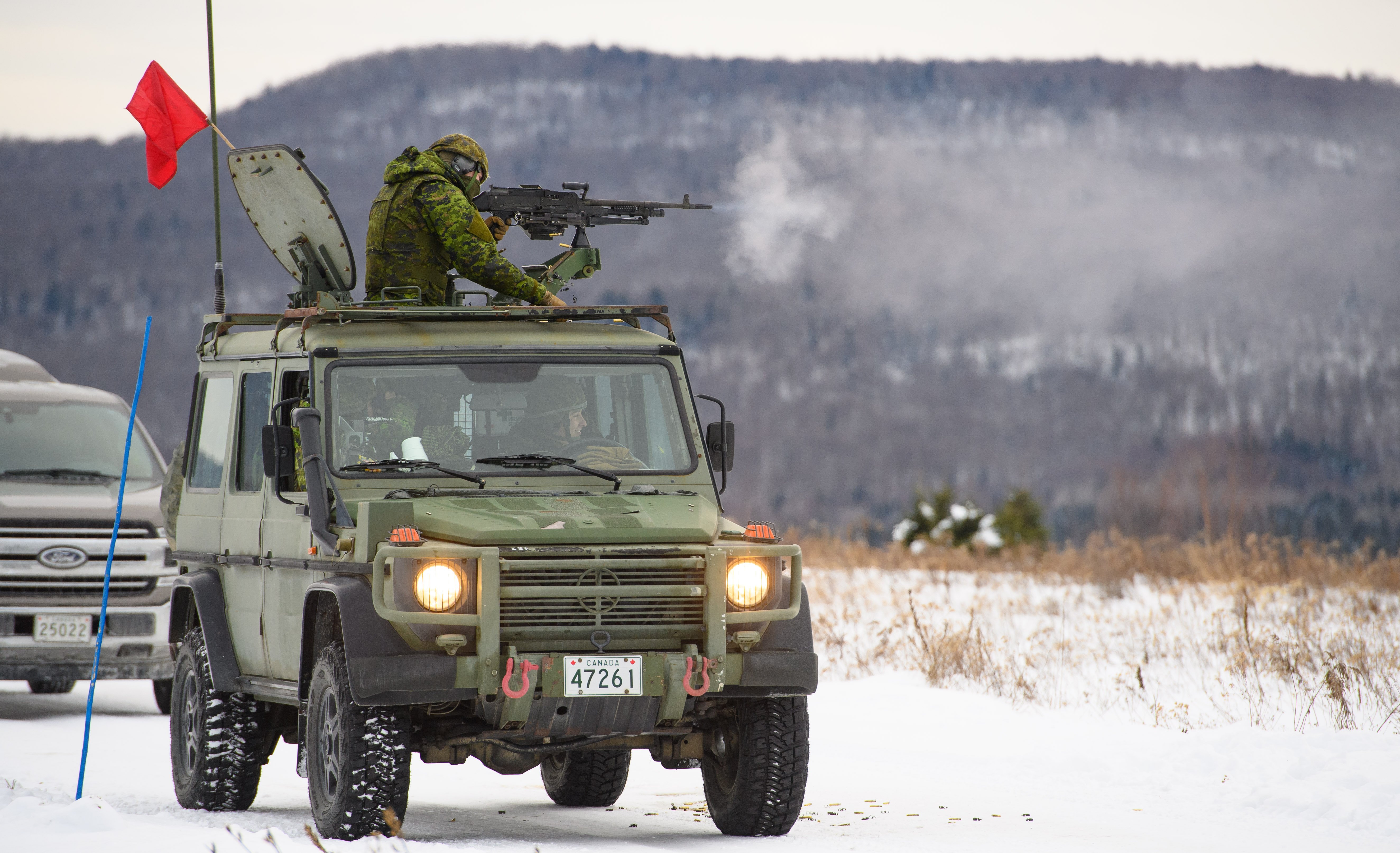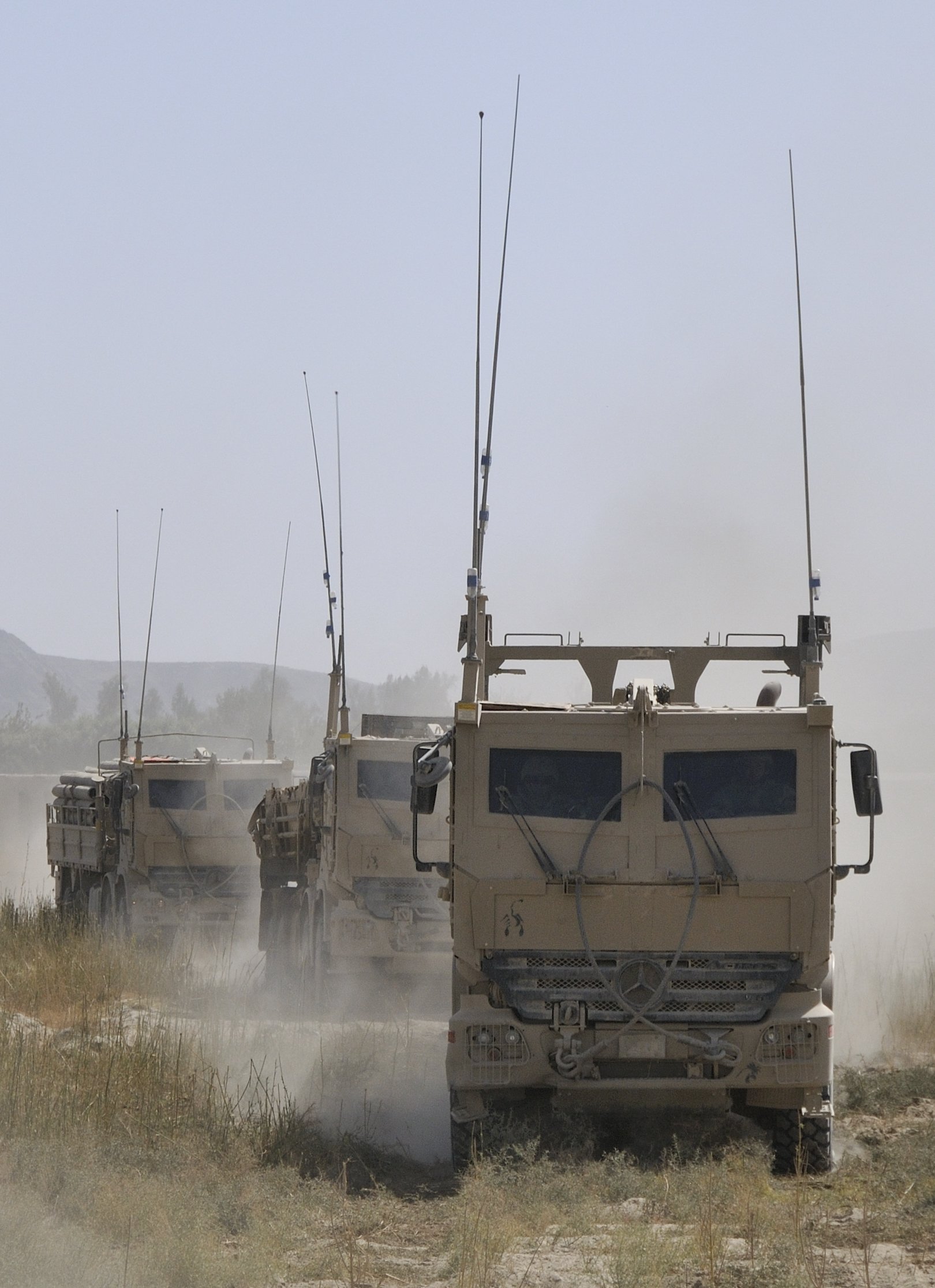CANADIAN ARMY - Canadian Army Vehicles Report
BY JOETEY ATTARIWALA
Keep on TRUCKIN’
 The Canadian Armed Forces (CAF) are undergoing a period of rejuvenation with force modernization as part of its efforts of reconstitution. This is essential as the Chief of Defence Staff’s directive for CAF reconstitution states that: adversaries and allies are outpacing us in the evolution of technology advancement and ability to operate in a pan-domain environment, making it an imperative for National Defence to evolve and improve itself to ensure we are a relevant and trusted partner.
The Canadian Armed Forces (CAF) are undergoing a period of rejuvenation with force modernization as part of its efforts of reconstitution. This is essential as the Chief of Defence Staff’s directive for CAF reconstitution states that: adversaries and allies are outpacing us in the evolution of technology advancement and ability to operate in a pan-domain environment, making it an imperative for National Defence to evolve and improve itself to ensure we are a relevant and trusted partner.
The directive further states that: this imperative will drive National Defence to invest in the Force Development and Design (FD&D) of the Future Force and work to implement new flexible and responsive procurement approaches in order to ensure the long-term effectiveness, relevance, and credibility of National Defence, and create a truly joint Defence Team that can seamlessly integrate in a whole of government approach to delivering on national security priorities.
Sadly the defence procurement process in Canada is woefully inadequate in so many ways, and that has led to programs often “shifting to the right” and that means they become more expensive, especially when factoring in inflation. One can perhaps appreciate how this can happen with complex procurements like ships and aircraft, but delays also happen with innocuous equipment acquisitions like trucks, which is the focus of this article, and sadly that means the CAF is operating with vehicles that are well past their ‘best before’ date. Examples of such wheeled vehicles are the Heavy Logistics Vehicle Wheeled (HLVW) which entered service in 1990 after a protracted selection process; and the Light Support Vehicle Wheeled (LSVW) which was selected in 1991 and entered service in 1993. Both of these fleets are becoming unsupportable.
One would think that trucks are relatively uncomplicated, and therefore easy to replace, yet the procurement process has proven to be an achilles heel, so it’s no wonder that potential recruits steer clear of a force with aging equipment, and that CAF members become disenchanted. With that said, there is light at the end of the proverbial tunnel. Projects like the Logistics Vehicle Modernization (LVM); Light Utility Vehicle (LUV); Light Forces Enhancement (LFE); Enhanced Recovery Capability (ERC); and Domestic and Arctic Mobility Enhancement (DAME) are all seeing movement in the right direction (note: DAME is a tracked vehicle). Among all projects, the concept of capability modularization has been a key element.
Most of the wheeled vehicle projects for the CAF fall under the Directorate of Land Requirements 6 (DLR 6) or DLR 5.
LVM  and a G Wagon.jpg)
The current CAF fleets of light (LSVW) and heavy logistics trucks (HLVW and HESV) and their associated equipment are in need of replacement due to their age and decreasing ability to meet operational requirements.
The Logistics Vehicle Modernization project will modernize and improve the light and heavy portion of the Logistics Fleets through the acquisition of new fleets of light and heavy logistics vehicles, trailers, vehicle modules, and armour protection kits. These vehicles are used by the CAF to transport personnel, equipment, and supplies in support of operations at home and abroad in support of Canadian National interests. They will also transport modules that can be used as spaces for functions such as cargo space, troop lift, ambulances, workshops, and command posts.
The project has a projected budget of $1-2 billion CAD, and will provide equipment with a minimum life expectancy of 20 years. This new, modern fleet will be able to carry a larger load, be more mobile, and provide increased protection to help ensure the CAF can continue meeting national and global missions. These missions will include situations such as disaster relief both in Canada and abroad during emergencies such as flooding, combat support, and peacekeeping overseas.
The LVM project will deliver one variant of light truck, four variants of light trailers, 14 variants of modules and an armour protection solution. It will also deliver seven variants of heavy truck, three variants of trailer, two variants of tractor trailer, five variants of module, flat racks and an armour protection system.
The LVM Request for Proposals (RFP) was released on December 9th 2021, and the project is currently under bid evaluation and a contract award is expected in 2023/24. The expected fielding date for Initial Operational Capability is likely not earlier than FY 27/28 according to a CAF document.
The LVM project is in addition to the separate Medium Support Vehicle System (MSVS) Standard Military Pattern (SMP) project which is the medium fleet solution that is already in service.
LUV
The CAF requires a protected, lightweight multi-role and highly mobile ground wheeled vehicle in order to conduct multiple battlefield roles and tasks across the spectrum of conflict. This includes, Combat roles, Command Support roles, Combat Service Support roles, Individual Training and Training support tasks. The current Light Utility Vehicle Wheeled (LUVW) fleet is comprised of a Standard Military Pattern (SMP) Mercedes G-Wagon and Militarized Commercial Off-The-Shelf (MilCOTS) Chevrolet Silverado truck, which have served the CAF since 2004.
The G-Wagon fleet includes the following variants: Command and Reconnaissance; Basic; and Military Police. The MilCOTS fleet includes the following variants: Cable-layer; Utility; and Military Police. Both the G-Wagon SMP and Silverado MilCOTS have reached their life expectancy; in fact, the Original Equipment Manufacturers (OEMs) of both fleets no longer produce the vehicles nor parts resulting in significant capability shortfalls.
The LUV project has a projected budget between $700 million to $1 billion CAD, and will deliver 2,000-2,200 light multi-role vehicles with up to four variants: Command and Reconnaissance Vehicle; Utility Vehicle; Military Police Vehicle; and Cable-Laying Vehicle. It will also deliver Ancillary equipment, Integrated Logistics Support (ILS); and an In-Service Support solution.
ER 
The Enhanced Recovery Capability (ERC) contributes to combat effectiveness by recovering vehicle casualties (where the tactical situation allows wheeled armoured fleets) to a location where it can be repaired, returned to combat, and/or denied from the enemy. The ERC project will replace the existing fleet of HLVW heavy tow trucks with an enhanced capability to match the new, heavier CAF wheeled vehicle fleets and the containerization of logistic vehicles. The project deliverables are expected to include heavy tow trucks and other special equipment for lifting and towing. Several armoured cab add-on kits or replacement cabs will be purchased to protect the crews when operating in high threat areas. ERC will be a single or dual-variant fleet comprised of ERC trucks and ERC Lifting and Controlled Righting System (LCRS) trucks.
The budget projected for the ERC is $250 - $499 million CAD, which will enable the CAF to procure up to 159 new heavy wreckers and up to 24 Armoured Protection Kits; Infrastructure; and Integrated Logistics Support & In-Service Support solution.
When the LVM project delivers, along with the ERC and in-service MSVS, this will represent a complete modernization of the fleet of logistics vehicles that will enable reliable support to domestic and expeditionary operations.
DAME
The Canadian Army needs a high mobility vehicle to move and survive for extended periods in the severe weather and terrain conditions found in the Arctic, in order to transport troops and equipment for safety, security and defence missions in Canada’s North. The in-service Bandvagn 206 (BV-206) vehicles are nearing their end of life. As a result, the CAF is more reliant on snowmobiles and light all-terrain vehicles which lack amphibious capabilities and environmental protection for the crew, are limited in troop and cargo carrying capacity, and are not designed for year-round use, nor are they suitable for casualty or medical evacuation, and all of that results in a greater dependency on limited and costly air medical services.
The CAF therefore needs a high mobility vehicle to transport personnel and equipment for extended periods in the extreme temperature and terrain conditions found in the Arctic. The Domestic and Arctic Mobility Enhancement Project is intended to be a key enabler for achieving present and future strategic goals in Canada’s North as well as enhance domestic response capabilities throughout all regions of Canada.
DAME is in the Optional Analysis phase and has a projected budget of $100 - $249 million CAD. The project will obtain a medium size, high mobility vehicle platform for the CAF that can provide the mobility, sustainment and communications required by forces employed in support of domestic operations. The platform will also provide essential mission support such as medical services and resupply. The project intends to deliver a common vehicle platform in 4 variants: Command Post; Troop Carrying; Cargo and Equipment Carrying; and Ambulance.
Specifically, DAME seeks to acquire up to 170 utility vehicles that can operate year-round in the Arctic and can move a light infantry section (10 soldiers) and crew (2 soldiers) 300 km while being self-sufficient for 72 hours.
LFE / LTV
The Light Forces Enhancement (LFE) project will deliver a new suite of vehicles to the Canadian Army specifically tailored to the Canadian Light Forces (LF) unique operational requirements.
As part of a review in support of the Adaptive Dispersed Operations concept, the Canadian LF need new light tactical personnel and cargo carrying capabilities. These capabilities will move soldiers and equipment across complex terrain which currently can only be reached on foot. It will lighten CAF soldiers’ on-person combat burden by carrying additional equipment and supplies, and will cover a larger area of operation through increased speed, range, and duration. This powerful, lightweight solution is expected to operate in domestic and expeditionary deployments, up to and including high threat environments; and enabling LF to keep up with mechanized elements of the Canadian Forces.
The project will deliver upgraded tactical mobility to Army LF including: Light Infantry, Artillery Tactical Groups, Light Engineers, Influence Activities, Intelligence, Electronic Warfare, as well as select Tranche 1 and 2 Reserve Mission Tasked (M/T) Infantry Units in 2,3, and 4 Divisions (mortars, direct fire support, pioneer platoons, Inf Recce Pl).
The LFE project has a projected budget of $50 - 99 million CAD, and will procure up to 330 ultralight tactical mobility platforms comprised of a mix of both Tactical Mobility Platforms - Personnel (TMP-P) and Tactical Mobility Platforms - Cargo (TMP-C) vehicles capable of being configured between both roles which will allow individual teams of soldiers to move themselves and the materiel necessary for completion of the mission efficiently, while minimizing fatigue, and sustain soldiers for its duration.
In support of Canada’s contribution to NATO Advanced Force Projection (aFP) in Latvia, as part of Operation REASSURANCE, Canada will procure Tactical Mobility Platform vehicles (TMPs) to equip a deployed Light Forces Battle Group starting in Fall 2024. This accelerated procurement is Phase 1 of LFE and is named Light Tactical Vehicle (LTV). An RFI was published on November 20th 2023, asking industry for options for Phase 1 - LTV which could acquire up to 108 vehicles.
Joetey Attariwala is CDR’s Senior Staff Writer

